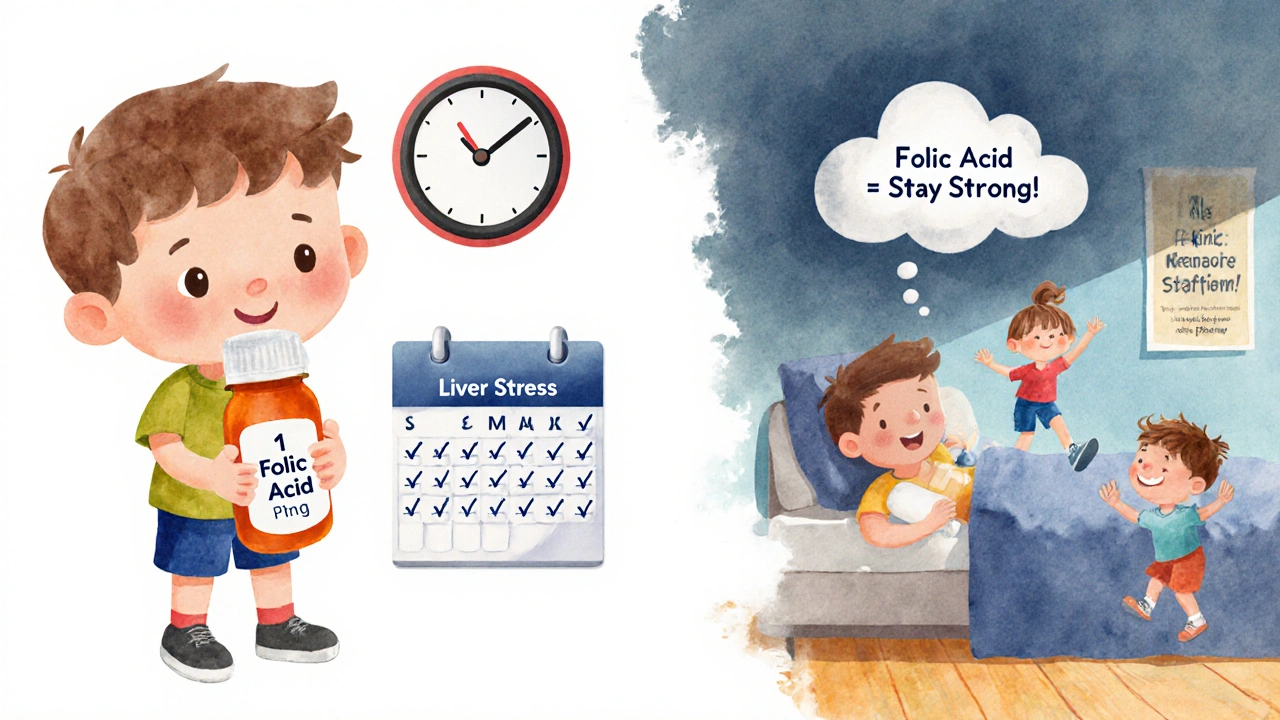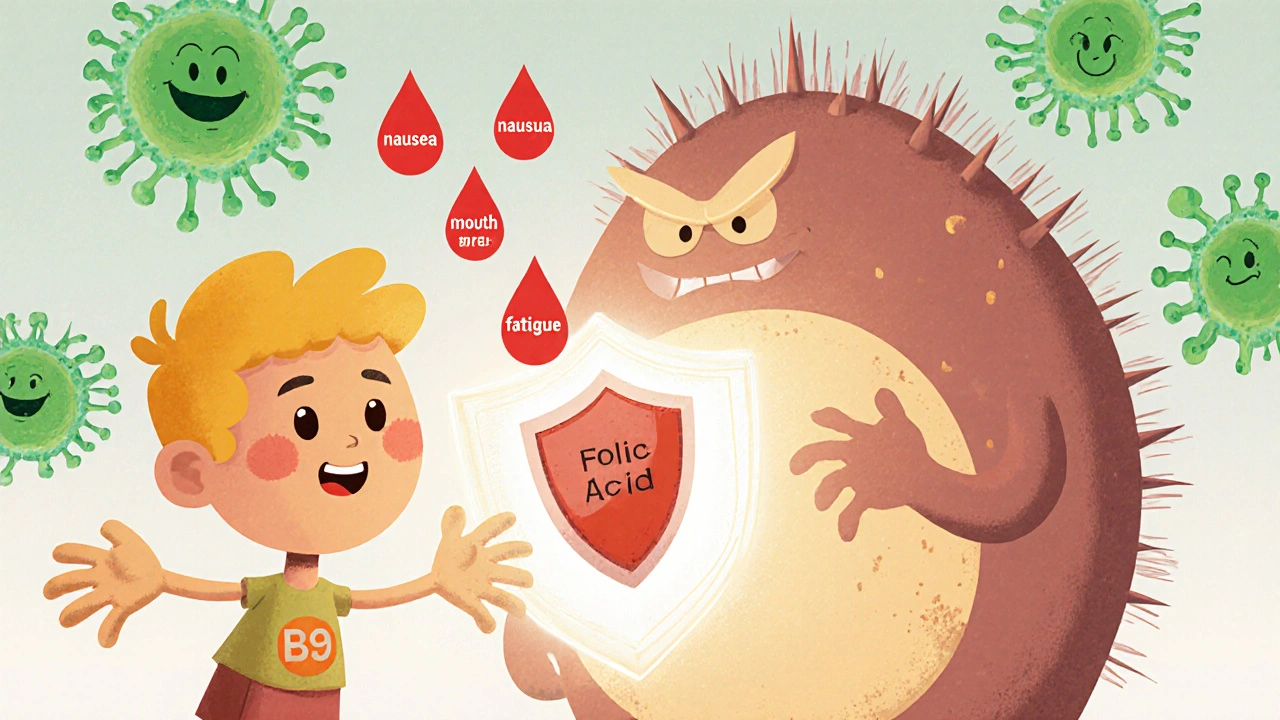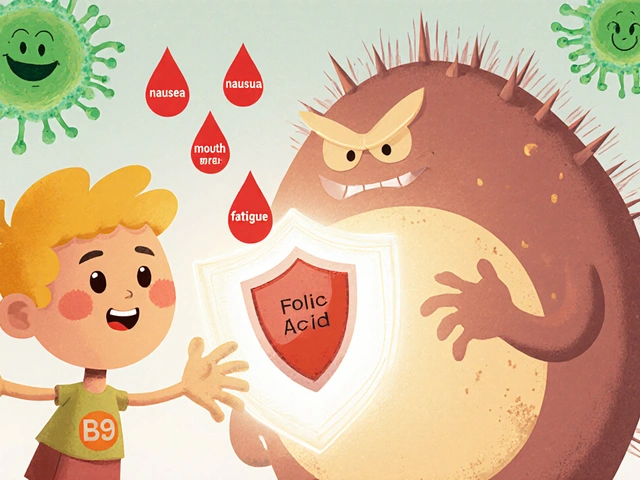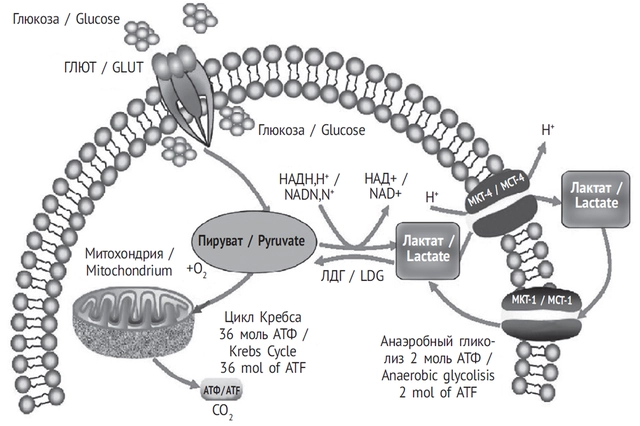When you’re prescribed methotrexate, whether for rheumatoid arthritis, psoriasis, or an autoimmune condition, the focus is often on how well it works. But there’s a quiet partner in this treatment that makes all the difference: folic acid. Skip it, and you might end up with nausea, mouth sores, or even liver stress-side effects that can make you quit the drug that’s actually helping your condition. The truth? Folic acid isn’t optional. It’s a safety net.
How Methotrexate Works-and Why It Harms Your Body
Methotrexate is a folate antagonist. That means it blocks a form of vitamin B9 your cells need to make DNA and repair themselves. It does this on purpose: in autoimmune diseases and cancer, it slows down overactive immune cells or fast-growing tumors. But your healthy cells-like those in your gut, bone marrow, and skin-also need folate to function. When methotrexate cuts off their supply, side effects kick in.
Up to 30% of people on methotrexate experience nausea, vomiting, or mouth ulcers. Liver enzymes can rise. Fatigue gets worse. These aren’t just annoyances-they’re signs your body is running low on the fuel it needs to stay healthy. And that’s where folic acid comes in.
Folic Acid Doesn’t Interfere with Methotrexate’s Effect
Here’s the big myth: taking folic acid will make methotrexate less effective. It won’t. Multiple studies, including one published in Arthritis & Rheumatology in 2018, show that patients who took 1 mg of folic acid daily had fewer side effects-without any drop in how well methotrexate controlled their disease. Another trial in The New England Journal of Medicine found that folic acid cut the rate of treatment discontinuation due to side effects by nearly half.
Doctors used to worry that folic acid would protect cancer cells or inflamed joints from methotrexate’s effects. That’s not what happens. Methotrexate works by flooding cells with a drug that jams folate pathways. Folic acid just gives your healthy cells a backup supply so they don’t starve. It’s like giving your body a detour around a roadblock, not removing the roadblock.
What Dose of Folic Acid Should You Take?
Not all folic acid is the same. You don’t need a prenatal vitamin with 800 mcg. You don’t need to take it every day. The standard recommendation is 1 mg (1000 mcg) of folic acid once a day, taken at least 24 hours after your methotrexate dose.
Some doctors prefer to give it once a week on a different day than methotrexate. Others suggest 5 mg once a week if side effects are severe. The key is consistency. Taking it randomly or skipping days defeats the purpose.
For most people, 1 mg daily works best. It’s enough to reduce nausea and mouth sores by up to 79%, according to a 2020 meta-analysis in Clinical Rheumatology. Higher doses aren’t better-they just cost more. And don’t confuse folic acid with methylfolate. Unless you have an MTHFR gene mutation (which is rare), regular folic acid works perfectly fine.
When to Start Folic Acid-And When It’s Too Late
Start folic acid the same day you start methotrexate. Don’t wait until your mouth starts hurting or you’re throwing up every week. By then, your body’s already stressed. Prevention is easier than repair.
If you’ve been on methotrexate for months without folic acid and you’re having side effects, it’s not too late. Many patients see improvement within two weeks of starting supplementation. Mouth ulcers heal. Nausea eases. Energy returns. One patient, a 58-year-old woman with rheumatoid arthritis, told her rheumatologist she’d been skipping folic acid because she thought it "wasn’t necessary." After starting 1 mg daily, her liver enzymes dropped back to normal within six weeks-and she stopped missing work due to fatigue.

What If You Forget?
Missing one day of folic acid won’t ruin your treatment. But if you miss several days in a row, side effects can creep back. Set a phone reminder. Put the bottle next to your toothbrush. Link it to a habit you already do.
If you accidentally take folic acid on the same day as methotrexate, don’t panic. Just skip your next dose of folic acid and resume the next day. Don’t double up. You’re not trying to overdose-you’re just keeping your cells fed.
Other Nutrients That Help
Folic acid is the star, but it’s not alone. Methotrexate can also lower levels of vitamin B12 and B6. These help process homocysteine, a compound that rises when folate is low and can increase heart disease risk.
Many doctors now recommend a B-complex supplement alongside folic acid. It’s not mandatory, but if you’re on methotrexate long-term, it’s smart. Look for a supplement with 2.4 mcg of B12 and 1.7 mg of B6. You can get these from food-eggs, lean meat, leafy greens-but most people don’t eat enough to make a difference.
Also, avoid alcohol. It competes with folic acid for absorption and can worsen liver stress. If you drink, even one glass a week, your risk of liver damage goes up. That’s not worth the risk when you’re already on a drug that affects your liver.
What About Natural Folate?
Can you just eat more spinach and lentils? Not enough. Natural folate from food is less stable and less bioavailable than synthetic folic acid. You’d need to eat over 2 cups of cooked spinach every single day to match 1 mg of folic acid. And even then, methotrexate blocks folate absorption in the gut. Supplements bypass that problem.
Folic acid is the only form proven to prevent methotrexate side effects. Leafy greens are healthy, but they’re not a replacement.

What Happens If You Don’t Take It?
Some patients think, "I feel fine, so why bother?" But side effects often sneak up. You might not notice the fatigue until you’re too tired to play with your kids. The mouth sores might seem like a cold sore-until they won’t heal. Liver damage? That’s silent until a blood test shows it.
Studies show that patients who skip folic acid are 2.5 times more likely to stop methotrexate because of side effects. That’s not just inconvenient-it’s dangerous. If methotrexate is the only thing keeping your disease under control, quitting it could mean more pain, more joint damage, or worse flare-ups.
How to Talk to Your Doctor
If your doctor didn’t mention folic acid, ask. Say: "I’ve read that folic acid helps reduce side effects from methotrexate. Can we start me on 1 mg daily?" Most rheumatologists and dermatologists know this. If they say no, ask for a referral to a specialist. This isn’t a fringe idea-it’s standard care.
Bring up blood work, too. Ask for a liver panel and homocysteine level every 3 to 6 months. These tests show if your body is coping well-or if you need to adjust your folic acid dose.
Final Takeaway
Methotrexate saves lives and improves quality of life for millions. But it’s not a magic bullet. It’s a tool that needs support. Folic acid isn’t a supplement you take for "general health." It’s a medical necessity. It’s the reason you can stay on the drug that’s working for you.
Take it. Don’t skip it. Don’t wait. Your body will thank you.
Does folic acid reduce the effectiveness of methotrexate?
No, folic acid does not reduce methotrexate’s effectiveness. Multiple clinical trials, including studies in Arthritis & Rheumatology and The New England Journal of Medicine, confirm that patients taking folic acid experience fewer side effects without any loss in disease control. Folic acid supports healthy cells without protecting diseased ones from methotrexate’s action.
How much folic acid should I take with methotrexate?
The standard dose is 1 mg (1000 mcg) of folic acid daily, taken at least 24 hours after your methotrexate dose. Some patients with severe side effects may need 5 mg once a week, but this should be guided by a doctor. Avoid higher daily doses unless prescribed-1 mg is sufficient for most.
Can I get enough folic acid from food instead of supplements?
No. Natural folate from foods like spinach, lentils, or broccoli is less stable and less absorbable than synthetic folic acid. Methotrexate also blocks folate absorption in the gut. To get 1 mg of folate from food, you’d need to eat over 2 cups of cooked spinach daily-practically impossible. Supplements are the only reliable way to prevent side effects.
When should I start taking folic acid?
Start folic acid on the same day you begin methotrexate. Waiting until side effects appear means your body is already under stress. Prevention works better than repair. If you’ve been on methotrexate without folic acid, start now-you’ll likely see improvement in fatigue and mouth sores within two weeks.
What if I take folic acid on the same day as methotrexate?
If you accidentally take folic acid on the same day as methotrexate, don’t double up the next day. Just skip your next folic acid dose and resume your regular schedule. One accidental overlap won’t cause harm, but consistent timing (folic acid 24+ hours after methotrexate) is key for optimal protection.
Do I need to take B12 and B6 with folic acid?
It’s not required, but recommended. Methotrexate can lower B12 and B6 levels, which helps process homocysteine-a compound linked to heart disease. A daily B-complex with 2.4 mcg B12 and 1.7 mg B6 can support overall health. Talk to your doctor about adding one if you’re on long-term methotrexate therapy.
Is alcohol dangerous with methotrexate and folic acid?
Yes. Alcohol competes with folic acid for absorption and increases liver stress. Methotrexate already affects liver function, and alcohol raises the risk of liver damage. Even moderate drinking (one drink a week) can be harmful. Avoid alcohol entirely while on methotrexate.





14 Comments
Scott Dill
Just started methotrexate last month and my doc didn’t mention folic acid at all. Found this post and switched to 1mg daily. Mouth sores? Gone. Nausea? Cut in half. I was ready to quit until I read this. Seriously, if your doctor didn’t tell you this, go back and demand it.
Jim Allen
lol why are we all taking supplements like we’re in a biohackers’ cult? 🤡 Methotrexate is a chemo drug. You think a vitamin pill fixes that? Nah. You’re just making your body think it’s not dying. Wake up.
Nate Girard
Jim, I get where you’re coming from, but this isn’t about biohacking-it’s about survival. I’ve been on methotrexate for 5 years. Without folic acid, I was in and out of the ER with mouth ulcers. Now I’m working full-time, hiking on weekends. It’s not magic, it’s medicine. 🙏
Carolyn Kiger
My rheumatologist in California pushed this hard. Said it’s like wearing a seatbelt in a car-doesn’t stop the crash, but keeps you alive. I started it on day one. Zero side effects. I’m 62 and still gardening. Folic acid isn’t optional. It’s the difference between suffering and living.
krishna raut
1 mg daily, 24 hours after methotrexate. Done. No drama. Works.
Prakash pawar
People think vitamins fix everything but they forget the real truth-pharma companies profit from supplements. Folic acid is cheap. Methotrexate is expensive. Coincidence? I think not. We’re being sold a lie wrapped in science. Real healing comes from diet and fasting, not pills.
MOLLY SURNO
Thank you for this thorough breakdown. I’ve been on methotrexate for three years and only learned about folic acid from a nurse practitioner, not my rheumatologist. It’s alarming how many providers still don’t emphasize this. I’m sharing this with my support group.
Alex Hundert
Prakash, your ‘real healing’ nonsense is dangerous. Folic acid isn’t a corporate plot-it’s a documented, peer-reviewed standard of care. People die or quit life-saving meds because of misinformation. Stop spreading fear and start reading the studies.
Emily Kidd
OMG I forgot my folic acid for 3 days last month and my tongue felt like sandpaper 😭 Started again and it’s like a miracle. Also, B12 helped my brain fog. I take it with my coffee now-no more forgetting!
Justin Cheah
Okay but have you considered that folic acid might be masking the real problem? What if your body is screaming for detox? What if the real issue is glyphosate in your food? Methotrexate is just a bandaid. Folic acid is just another chemical crutch. The FDA knows this. They’ve suppressed studies showing folic acid increases cancer risk in high doses. You think your doc is telling you the truth? Look up the 2017 NIH whistleblower report. They’re lying to you.
caiden gilbert
Reading this felt like someone handed me a flashlight in a dark tunnel. I was about to quit methotrexate because I thought the fatigue was just ‘part of it.’ Turns out I was just vitamin-starved. Now I’m taking folic acid + B-complex like it’s my new religion. My energy’s back. I can hold my kid without crying. This isn’t just medical advice-it’s a lifeline.
phenter mine
so i started taking folic acid and it helped a lot but i think i might have misspelled somethin in my notes and took it on the same day as methotrexate once… hope i didnt mess up my liver lol
Aditya Singh
While folic acid supplementation is statistically significant in reducing GI toxicity, the pharmacokinetic interaction is confounded by MTHFR polymorphism prevalence in non-Caucasian populations. The meta-analyses cited lack stratification by SNP haplotype, rendering generalizable dosing recommendations epistemologically flawed. You’re applying a one-size-fits-all paradigm to a polygenic metabolic pathway. That’s not medicine-that’s protocol theater.
Katherine Reinarz
my doctor said i dont need it and now my mouth is bleeding and i feel like i’m dying and no one listens to me 😭😭😭